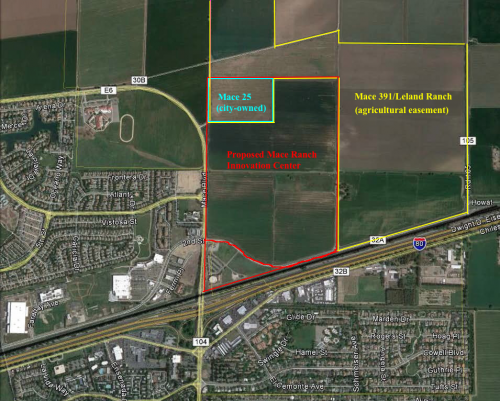 By Roberta Millstein
By Roberta Millstein
This Wednesday, July 19, the Planning Commission will vote on whether to recommend the certification of the Mace Ranch Innovation Center (MRIC) Environmental Impact Report (EIR). In discussions of the EIR so far, many have raised concerns about the inclusion of 25 acres of City-owned land at Mace curve in the MRIC proposal and EIR. Some have asked about the history of its inclusion.
Staff has provided some of this history for the Wednesday meeting. However, it is incomplete. As a commissioner on the Open Space and Habitat Commission (OSHC) since September 2010, I have been part of many of the discussions about the 25 acres, and to help fill in the missing history, I have put together the following timeline, based on staff reports and minutes from Council and Commission meetings.
I believe that this history shows that the City promised citizens that the 25 acres, purchased with open space funds, would be retained as open space, despite considering on several occasions whether to go back on that promise.
October 2010 – OSHC voted unanimously to recommend acquisition of 390 acres at Mace Curve because the property ranked highly in two acquisition priority categories established by the City, Urban Fringe and Agricultural Resources, with moderate/high Scenic Resources and low/moderate Biological and Natural Resources.
November 2010 – City Council approved purchase option.
April 2011 – Yolo Land Trust (YLT) received a $1,125,000 Natural Resource Conversion Service (NRCS) grant to permanently protect Mace 390.
September 2011 – City completed the purchase of Mace 390. Quoting from a staff report of September 2012: “The objective, at the time of the purchase, was to protect the Property with an agricultural conservation easement and resell the easement-protected property to a conservation buyer that would keep the land in agricultural production.”
October 2012 – OSHC recommended that the City Council approve resale of the Mace Curve property as one parcel and conservation easement while retaining approximately 30 acres for a community farm.
November 2012 – Innovation Park Task Force identified Mace 390 as one of four locations as appropriate for a potential innovation business park. OSHC was not consulted.
Late 2012-early 2013 – City staff had internal discussions about the potential for swapping privately–owned land for Mace 390 to put a business park at Mace 390. OSHC was not consulted.
March 2013 – NRCS and YLT granted the City’s request for an extension of the March 31, 2013 easement closing deadline to explore its options regarding the property. Deadline extended to May 31, 2013.
May 2013 – NRCS and YLT granted second City request for an extension to June 15, 2013.
June 2013 – OSHC heard about proposed “land swapping” for the first time, but OSHC only “cursorily advised” (Staff’s language) of this plan. Staff recommended declining the NRCS grant for  Mace 390 conservation easement to allow the City to explore resale options, but OSHC strongly reaffirmed its previous recommendations to place a conservation easement on the property and establish a community farm on approximately 30 acres of it. City Council unanimously supported OSHC recommendation, approving the resale of Mace 390 (now called Leland Ranch) with a conservation easement. NRCS granted YLT an extension to close the easement transaction to March 31, 2014 (one year from the original expiration date of March 31, 2013).
Mace 390 conservation easement to allow the City to explore resale options, but OSHC strongly reaffirmed its previous recommendations to place a conservation easement on the property and establish a community farm on approximately 30 acres of it. City Council unanimously supported OSHC recommendation, approving the resale of Mace 390 (now called Leland Ranch) with a conservation easement. NRCS granted YLT an extension to close the easement transaction to March 31, 2014 (one year from the original expiration date of March 31, 2013).
October 2013 – OSHC voted unanimously to reaffirm its support of Council’s June 2013 decision to place a permanent conservation easement on the property and establishment of a community farm on 27 acres; the Commission further advised the Council first to use the Commission to evaluate any open space alternatives that may arise in connection with this property. Staff initiated survey work to establish 27-acre parcel for potential community farm.
Sept-Nov 2013 – Offers accepted on resale of 364 acres of Leland Ranch (now measured at 391 acres, deducting 27 acres for proposed community farm. 27 acres later revised to 25 acres).
November 2013 – Council again reaffirmed its intention to resell Leland Ranch with a conservation easement, which it did shortly thereafter.
July, October 2014 – Inclusion of the 25-acre parcel in the MRIC application – an approximately 200-acre parcel to the south of Leland Ranch – was discussed at City Council meetings as a part of Innovation Center agenda items.
August 2015 – OSHC began discussion of MRIC draft EIR.
November 2015 – OSHC submitted its comments on the MRIC draft EIR, including numerous comments objecting to the inclusion of the 25 acres in the proposal and the failure of the proposal to take into account the history of that land and the impact of its inclusion in the proposal.
March 2016 – OSHC was not given an opportunity to comment on the Mace final EIR or to say whether it thought its concerns had been adequately addressed, but it voted unanimously to recommend “that the City’s 25 acres of open space – acres that were purchased by the City with open space funds to be used as open space – are kept as open space, either as a farm or habitat area. There should be no buildings on the City’s 25 acres of open space, except those necessary to maintain the farm and/or habitat area.”
The Staff report for Wednesday’s Planning Commission meeting makes it sound as though the issue is whether a community farm is appropriate for the 25 acres. The above history shows that that is not the issue.
The issue is that the 25 acres was purchased with open space funds, that the promise to keep it as open space was reiterated by several City Council decisions, that the land was retained by the City on a recommendation from the OSHC which would have kept the land as open space (and the OSHC would not otherwise have made the recommendation that the City retain the land), and that the land need not be a community farm but could also be retained as habitat or for other open space use.
The MRIC EIR takes none of this into account. I urge the Planning Commission to reject the certification of the EIR for this reason.
Roberta Millstein has been a resident of Davis since 2007 and a commissioner on the Open Space and Habitat Commission since 2010. She is a professor in the Department of Philosophy at UC Davis, specializing in philosophy of biology and environmental ethics. All opinions expressed here are hers alone.






Much appreciated, Roberta. Can you clarify the difference/boundaries of Mace 390, vs. 391? (The map only identifies 391/Leland Ranch.)
Glad that was helpful, Ron, and sorry not to be clearer about 390 vs 391. In Sept-Nov 2013 it became clearer that what we’d thought was around 390 acres was really closer to 391 acres. So, it’s the same parcel.
Compounding the problem of selling off the open space and betraying the public trust is the fact that Burrowing Owls currently occupy the 25-acre site which fact is overlooked in the EIR because surveys were not properly conducted.
In particular, the burrowing owl surveys were not conducted during times when burrowing owls would reasonably be expected to be present. Burrowing owls in California are most active and most visible during breeding season which generally runs from February 1 through August 31. California Department of Fish and Wildlife’s Staff Report on Burrowing Owl mitigation guidelines 2012 provides that the surveys optimally should occur between April 15 and July 15, the peak of the breeding season, when burrowing owls are most detectable. Several researches recommend three or more surveys during daylight hours. The surveys performed for the MRIC project were conducted in October and December of 2014, out of the breeding season and were thus insufficient. Perhaps, not surprisingly, no owls were sighted.
In fact, burrowing owls have been documented on numerous very recent occasions by numerous individuals at the MRIC project site. Therefore, due to the presence of burrowing owls at the site, the project would have permanent, significant adverse impacts on the burrowing owls, a listed species, in the project area, directly on natal burrows within 150 meters of the project, through habitat modification, and through loss of foraging habitat.
As set forth in Appendix A of the CDFW Staff Report, such permanent loss of burrowing owl habitat requires the replacement of the lost habitat with an area equivalent or greater for breeding, foraging, wintering and dispersal of young, and such site demonstrate “presence of burrows, burrow surrogates, fossorial mammal dens, well-drained soils and abundant and available prey within close proximity of the burrow.”
If mitigation lands are acquired through a mitigation bank, the project proponent should provide the City with a burrowing owl survey as evidence there are burrowing owls on the mitigation lands. In the absence of such mitigation offered, the EIR cannot be properly certified as adequate.
Thanks, Alan. You’ve described another serious problem with the EIR.
Wondering how the preservation of a small site for burrowing owls within the Marriott Residence Inn proposal will impact the need for foraging areas at adjacent sites (including the proposed site of MRIC, as well as the 25-acre city-owned site). (By the way, I sincerely appreciate the effort that led to the burrowing owl site within the planned Residence Inn development. Efforts like that are what makes Davis stand out from other communities – in a good way.)
I imagine that it’s pretty difficult for owls (or most wild animals) to live on a small patch of land, surrounded by development. (I realize that some may not “care” about such issues.)
Here’s an article regarding the settlement which should enable burrowing owls to continue living on the Marriott Residence Inn property (assuming that they have sufficient habitat nearby, to hunt):
http://www.davisenterprise.com/local-news/burrowing-owl-society-settles-hotel-lawsuit/
Who doesn’t love burrowing owls? (Other than rodents – and some, but not all developers. I will try to avoid linking the two “groups” who don’t like burrowing owls.)